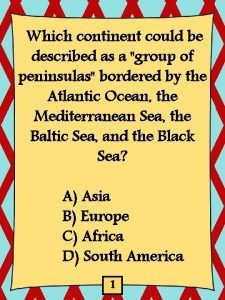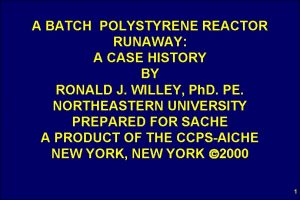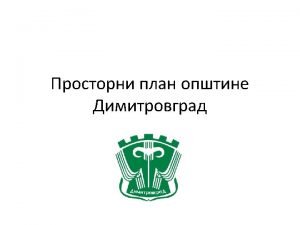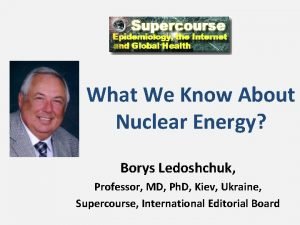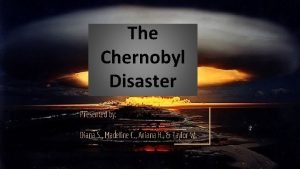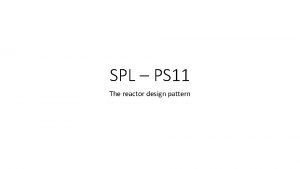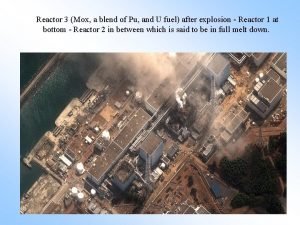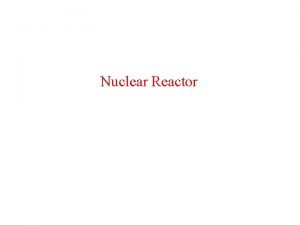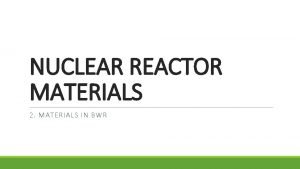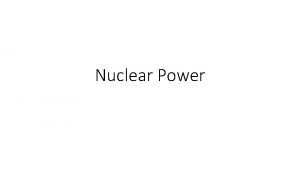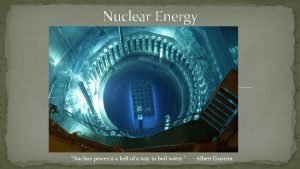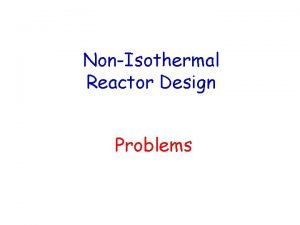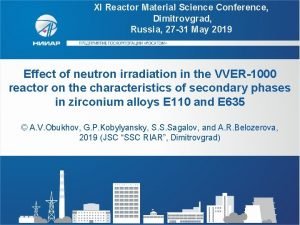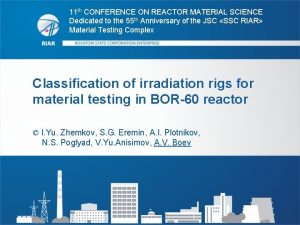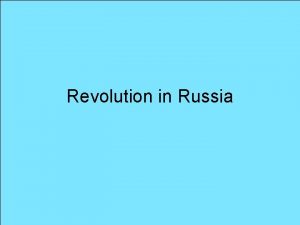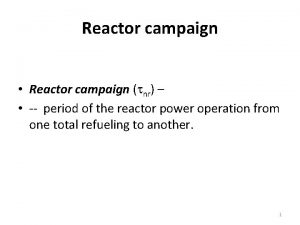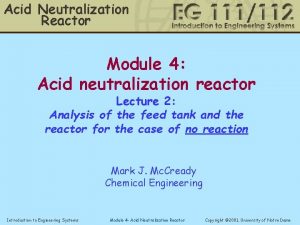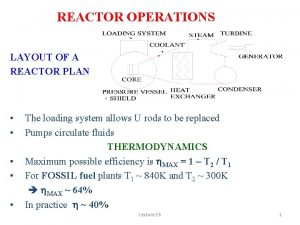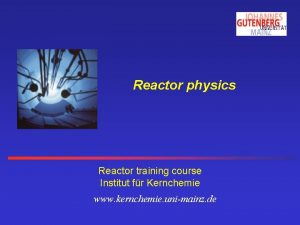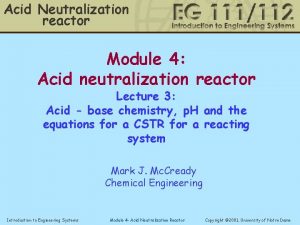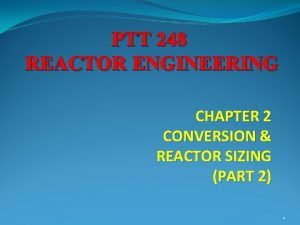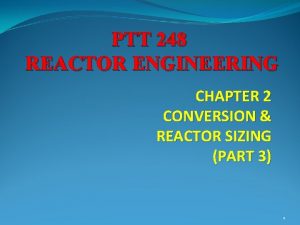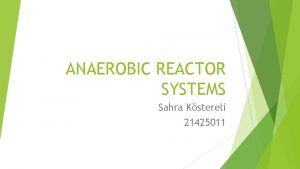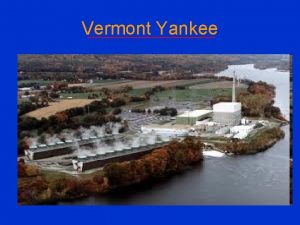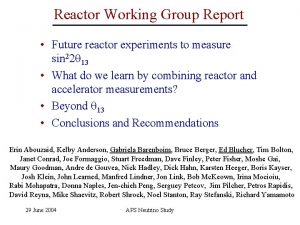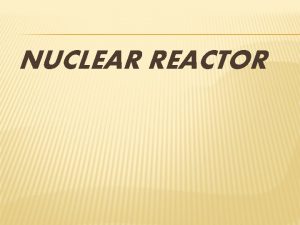XI conference on reactor material science Russia Dimitrovgrad



















- Slides: 19

XI conference on reactor material science, Russia, Dimitrovgrad, May 27 -31, 2019. ANALYSIS OF VVER-1000 FUEL RODS ELONGATION UNDER THERMAL TESTS SIMULATING DRY STORAGE CONDITIONS © G. P. Kobylyansky, A. O Mazaev, E. A. Zvir, P. A. Ilyin, A. V. , Grin P. I. , Obukhov A. V. , 2019 (JSC “SSC RIAR”, Dimitrovgrad)

INTRODUCTION v Experimental data on the fuel rods behavior under thermal testing conditions in an inert environment are necessary to substantiate reliable and safe methods for the VVER-1000 FAs dry storage v To conduct model experiments, a conservative approach is usually used, where more stringent test parameters than those expected in reality are chosen. v One of such approaches involves thermal testing of fuel rods at a constant temperature (380° C in our case), including thermocycles. v Elongation of VVER-1000 fuel rods with increasing time of thermal testing was revealed. v The maximum elongation was observed for low-burnup fuel rods Experimental studies were done by order of TVEL JSC; fundamental aspects of radiationinduced phenomena in fuel claddings were studied under the support of RFFI (project No. 1908 -00799 A). 2

OBJECTS OF EXAMINATION Parameters, mm Thermal test conditions Stationary mode Thermocycling No testing (witness fuel rods) Fuel rod elongation, mm FA # Burnup, MW day/kg. U 1 20 7, 57 / 1, 5 6, 0 2 72 7, 57 / 1, 4 0, 5 1 19 7, 57 / 1, 5 2 70 7, 57 / 1, 4 0, 8 1 20 7, 57 / 1, 5 - 2 72 7, 57 / 1, 4 - Fuel pellet Dout/Dch Cladding D/d 9, 1 / 7, 73 9, 5 Cladding are made of alloy E 110 based on electrolytical zirconium. The spring stopper is made of steel EK 173 -ID. 3

THERMAL TEST MODES 4

KINETICS OF FUEL RODS ELONGATION UNDER THERMAL TESTING Stationary mode Thermocycling 5

CHANGES IN THE AVERAGE HOOP STRAIN DURING TESTING Thermocycling Burnup, MW day/ кг. U 19 70 Average fuel rod diameter increment (%) at locations 250 -3250/3250 -3750 mm during testing 8 days 0, 10/0, 11 0, 08/0, 13 15 days 267 days 277 days 297 days 427 days 0, 10/0, 11 0, 17/0, 22 0, 21/0, 29 0, 28/0, 49 0, 07/0, 11 0, 16/0, 28 0, 20/0, 32 0, 20/0, 49 0, 39/0, 64 Stationary mode Burnup, MW day/ kg. U 20 72 Average fuel rod diameter increment (%) at locations 250 -3250/3250 -3750 mm during testing 103 days 318 days 468 days 0, 11/0, 17 0, 09/0, 20 0, 15/0, 28 0, 16/0, 38 0, 28/0, 38 0, 29/0, 60 6

FGR VS. VVER-1000 FUEL RODS BURNUP* * Dependence plotted using data of Ref. : [Kobylyansky G. P. et. al. Proc. JSC "SSC RIAR". 2018. № 4. Pp. 12 -22]. 7

DIAGRAMS OF VALUES 0, 2 OF RING SAMPLES CUT OFF FROM FUEL ROD MIDDLE. Тtest=380 С 8

ANNEALING OF DISLOCATION LOOPS UNDER THERMAL TESTING 20 MW day/kg. U Dср= 18, 2 nm And linear dislocations Dave=9, 6 nm 70 MW day/kg. U Linear dislocations Dave=8, 5 nm No thermal tests After thermal tests 9

EFFECT OF THERMAL TESTS ON <c>-DISLOCATIONS 70 MW day/kg. U Specific density = 16 1013 m-2 No thermal tests = 12 1013 m-2 After thermal tests 10

FACTORS AFFECTING FUEL RODS ELONGATION v Gas pressure under the cladding causes tensile stresses that increase as the temperature rises thus creating conditions for thermal creep, i. e. cladding dimensional changes v Crystallographic texture causes anisotropy of dimensional changes of items in the absence or presence of mechanical stresses v Density of zirconium hydrides is lower than of the cladding material (E 110), their presence can lead to an increase in the cladding dimensions v A partial return of 0, 2 to initial values caused by radiation defects contributes to higher cladding creep rate, as compared to witness fuel rods, due to higher effective level of stress v In fuel rods with lower burnup, the entire cladding length is subject to creep under gas pressure, and in fuel rods with higher burnup, only those parts that are not adhered to fuel. v Thermal cycling can increase creep [Baranov A. A. Naukova Dumka. Kiev, 1974] v Additional axial loads cause an increase in the cladding stress ratio in the axial and tangential directions and a change in the direction of its deformation. 11

FUEL RODS ELONGATION BY A PRESSURIZED TUBULAR SAMPLE Lspr Mode Lр , mm Lspr, mm Na , N Stat. T/c 3658 3652 138 132 24 31 Lspr Lр Lр1 Lр =Lр1+Lр2 Mode Lр , mm Lspr, mm Na , N Stat. T/c 3671 122 40 40 Lр2 20 MW day/kg. U 70 MW day/kg. U 12

STRESS IN CLADDINGS =Р 0×(273+380)×d/2× 293 t 12, 6 Р 0 (MPa) A = 4 NA/(D 2 -d 2) + Ptd 2/(D 2 -d 2) where Р 0 – in-rod gas pressure at a room T (293 К); d – cladding ID; t – cladding wall thickness, NA – external axial load, D – cladding OD, Рt – inner pressure at Тtest. At Na=0: A/ = 0, 63 In a free state, the length of spring compensating part L=155± 5 mm. Spring force after operation 0, 115 kgs/mm 1, 13 N/mm. For fuel rods 20 MW day/kg. U, Т= 20 С: • Stationary mode – L = 138 mm Na= (155 -138) 1, 13 19 Н • Thermocycling – L= 132 mm Na 26 Н At Т=380 С accounting thermal expansion of uranium dioxide, alloy E 110 and spring steel: • Stationary mode - Na 24 Н • Thermocycling - Na 31 Н A/ 0, 74 A/ 0, 76 13

EFFECT OF TEXTURE AND AXIAL LOAD It is well-known [Holt, ASTM STP 1505, P. 3 -18] that strain of a tube in main directions is proportional to factor Gd = 1 - 3 fd, i. e. , the less f. A, the higher axial strain. For E 110 cladding tubes the structural and textural features are almost the same because of their production technology: f. T 0, 3; f. R 0, 6; f. A 0, 1 [Physical Material science, Vol. 6, Part 1, p. 123]. Experimental data on pressurized sample creep are known: v For pressurized tubes from alloy Zr-2, 5%Nb, both increase and decrease in the sample length under thermal testing are sensitive to relation A/ . Thus, at a certain relation of Kern’s texture coefficients at A/ < 0, 48, the length decreases while at a higher value, elongation is observed. [Li et al, ASTM STP 1529, P. 298 -326]. v Increase in the diameter of pressurized cladding tubes from alloy E 110 is accompanied by a reduction in their length [Thesis by Dr. A. Ya. Rogozyanov]. In our case, a low additional axial load increase A/ causes changes in the pressurized tube strain direction. 14

EFFECT OF HYDRIDES AND PARTIAL RETURN OF 0, 2 v The contribution of hydrides (regardless of their orientation) to the fuel rods length change is negligible (according to calculations made in [Menibus, A, et al. J. of Nucl. Mater. 2013. V. 440. P. 169 -177. ]), and can be excluded from consideration. v A ~1, 2 time decrease in 0, 2 causes the same increase in effective stress for creep to appear on the cladding area that are not in contact with fuel v In the longitudinal direction of cladding , a return of 0, 2 can occur, with a high probability, to a greater degree than in the transverse direction, thus increasing the effective stress, which affects the creep rate in this direction. However, experimental data on the change in the anisotropy of mechanical properties during post-irradiation annealing are not yet available. 15

THERMOCYCLING EFFECT v The thermocycling testing results in the fuel rods elongation rate higher than in the stationary mode (slide 5) v The elongation rate decreases with increasing cycle time v Under short testing cycles, the strain kinetics corresponds to the first (unsteady) creep stage with a rate higher than at the steady-state stage. Therefore, the strain increase during short thermocycles is higher than in tests with longer cycles or in stationary mode. v A small shortening of the fuel rods at the initial testing stage may be due to the fact that the annealing of radiation defects in the cladding was still insufficient for a meaningful return of the yield strength affecting the ratio of effective stress in axial and tangential directions. 16

EFFECT OF FUEL-TO-CLADDING INTERACTION v In 70 MW day / kg. U fuel rods, fuel is adhered to the cladding over most of the kernel length, and the model of a pressurized tubular sample can be only applied to the section where the fuel-to-cladding gap remains. Then, the axial load from the compressed spring will affect only on the upper part of the cladding on the length ~270– 290 mm (section with the fuel-to-cladding gap and the length of spring compensating part in the gas plenum). This is ~13 times shorter than the working length of 20 MW day/kg. U fuel rod claddings. v The difference between the elongation of fuel rods with burnup 20 and 70 MW · day/kg. U is 12 times (6. 0 / 0. 5 = 12 for stationary tests and 9. 5 / 0. 8 = 11. 9 for thermocycling). v The lower part of the 70 MW-day kg. U fuel rod claddings where the fuel-tocladding gap remains, can also elongate due to the difference in thermal expansion coefficients of the cladding and fuel. This partially compensates for the indicated difference. 17

CONCLUSION v Factors have been analyzed that could lead to the elongation of the fuel rods spent in the VVER-1000 reactor for 1 and 6 years up to 20 and 70 MW day/kg. U, respectively during thermal tests simulating dry storage conditions. v Values have been estimated of axial loads in fuel rods caused by compressed spring stoppers, which increase the ratio of axial and tangential stresses in the claddings, causing the fuel rods to elongate by the creep mechanism. v Higher elongation of low-burnup fuel rods, as compared to higher-burnup ones, is because the creep process involves more extensive cladding areas not adhered to fuel. v Thermocycling leads to a greater fuel rods elongation, as compared to the stationary mode, due to the higher cladding creep rate at the unsteady stage during short cycles. 18

THANK YOU FOR ATTENTION! Leading Scientist G. P. Kobylyansky Tel. : 8(84235)73958 E-mail: gpk@niiar. ru
 Which number on the map represents the english channel?
Which number on the map represents the english channel? Reactor for eps material
Reactor for eps material Sofia nis km
Sofia nis km Conversation about favorite subject
Conversation about favorite subject Gd and t symbol
Gd and t symbol Standard costing and variance analysis formula
Standard costing and variance analysis formula Example of material culture
Example of material culture What is real culture
What is real culture Non material culture examples
Non material culture examples Useful and harmful materials in the house
Useful and harmful materials in the house Fission reactor nuclearcraft
Fission reactor nuclearcraft Artur korneyev
Artur korneyev Reactor design pattern
Reactor design pattern Reactor pattern
Reactor pattern Magical reactor 3
Magical reactor 3 Which control
Which control Boiling water reactor
Boiling water reactor Anatomy of a nuclear reactor
Anatomy of a nuclear reactor Rbmk reactor design flaws
Rbmk reactor design flaws Non isothermal reactor design problems
Non isothermal reactor design problems
